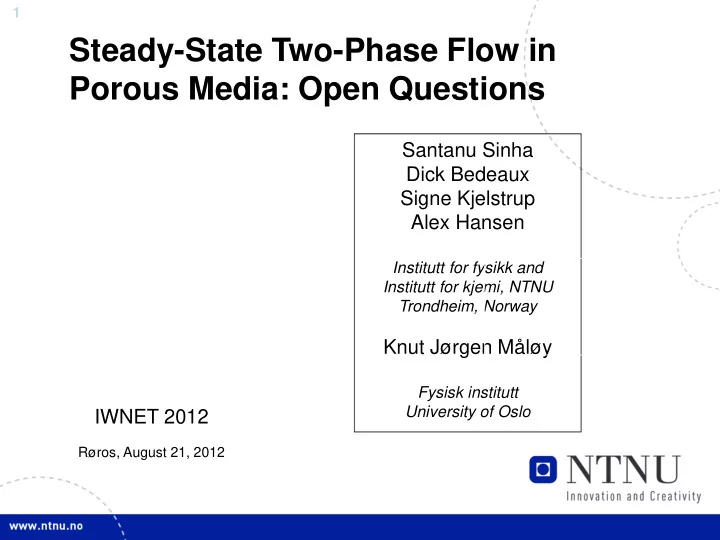

1 Steady-State Two-Phase Flow in Porous Media: Open Questions Santanu Sinha Dick Bedeaux Signe Kjelstrup Alex Hansen Institutt for fysikk and Institutt for kjemi, NTNU Trondheim, Norway Knut Jørgen Måløy Fysisk institutt University of Oslo IWNET 2012 Røros, August 21, 2012
2 Ground to be Covered: 1. Steady-State Flow in the Laboratory 2. Steady-State Flow on the Computer 3. Nonlinear Rheology 4. Statistical Mechanics of Porous Media Flow
3 1. Steady-State Flow in the Laboratory
4 Steady-State Flow in the Laboratory Both fluids move and fluid clusters break up and merge ; still steady state. A setup for studying steady-state flow in the laboratory: Region of spatially homogeneous steady-state flow . Tallakstad et al., Phys. Rev. Lett. 102 , 074502 (2009); Phys. Rev. E 80 , 036308 (2009).
5 2. Steady-State Flow on the Computer
6 Numerical Model: Network of Connected Pores Knudsen et al. Transp. Por. Med. 47 , 99 (2002).
7 Largest non-wetting Steady-state Flow on a Torus cluster. Flow Direction Hansen and Ramstad Comp. Geosci. 13 , 227 (2009)
8 Flow Rate Distribution Sinha, unpubl. (2011) High-speed channels Local flow rates 0 10 -5 10 -4 10 -3 10 -2 10 -1 1
9 3 Dimensions: Reconstructed pore networks Pore Network from Berea Sandstone (3mm) 3 Each pore is described by a number of geometric parameters. Reconstruction by e.g. merging thin slices
10 Evolution towards steady-state flow Steady state Ca = 0.015, M = 1, S = 0.5 non-wetting saturation
11 Largest non-wetting clusters at different saturation levels in steady state S=0.65 Ca=0.015, M=1 S=0.67 S=0.59 S=0.71 Critical saturation
12 Knudsen and Hansen, Europhys. J. B 49 , 109 (2006) Single vs. Two-Phase Flow (in 2D) Three-dimensional parameter space: • Saturation S • Viscosity Ratio M • Capillary Number Ca Both fluids move Only one fluid moves
13 3. Nonlinear Rheology
14 Flow through a single tube Sinha et al. to be submitted this week (2012)
15 Motion of bubble This is the driven overdamped pendulum
16 Saddle-node bifurcation Effective response of single tube Effective conductivity
17 Experimental study of Steady-State flow in Hele-Shaw Cell Tallakstad et al. Phys. Rev. Lett. 102 , 074502 (2009) Flow rate ∆ P ∝ Q 0.54 Pressure Drop
18 Experiment in radial 3D geometry Rassi et al. New J. Phys. 13 , 015007 (2011). ∆ P ∝ Q β
19 Behaves as a Bingham Plastic ”Newtonian” fluid with a yield threshold Intuition: (Roux and Herrmann, Europhys. Lett. 4 , 1227 (1987).) •Change pressure over network by δ ( ∆ P). •Number of additional links begin to flow: δ N ~ δ ( ∆ P). •Conductance of network change by δΣ ~ δ N ~ δ ( ∆ P). •Integrate to find Q ~ ( ∆ P- ∆ P c ) 2 . Bingham plastic
20 Effective medium theory Generalized Darcy equation: Sinha and Hansen, Europhys. Lett., in press (2012).
21 Numerical results Torroidal boundary conditions ∆ P c is independent of viscosity ratio M, but depends on saturation s. Open boundary conditions
22 ∆ P c is independent of The threshold pressure ∆ P c viscosity ratio M, but depends on saturation s. Optimal path landscape: Talon et al., in preparation (2012) ∆ P c = min path Σ i ∈ path ∆ p c i
23 Reanalyzing the Rassi et al. data.
24 Single link Network q ~ ( ∆ p – ∆ p c ) 1/2 Q ~ ( ∆ p – ∆ p c ) 2
25 Experimental study of Steady-State flow in Hele-Shaw Cell Tallakstad et al. Phys. Rev. Lett. 102 , 074502 (2009) ∆ P ∝ Q 0.54 vs. ∆ P- ∆ P c ∝ Q 1/2 System prepared so that one of the fluids percolates: ∆ P c ≈ 0. (There is some curvature)
26 4. Statistical Mechanics of Porous Media Flow
27 Returning to the concept of a state. Sinha, 2012
28 Sequence of configurations through time integration: 1 2 3 4 ∆ t ∆ t ∆ t ∆ t The order of the configurations has been randomized: 3 1 4 2 This randomization does not change the statistics.
29 If order plays no role: All steady-state properties will be completely described by the configurational probability distribution Π {cf} where {cf} signifies the positions of all interfaces between the immiscible fluids in the porous medium. A configuration is fully described by the position of all interfaces. This leads to a statistical mechanics for porous media.
30 Metropolis Monte Carlo Sampling Configurational probability Π {cf} Old configuration Test configuration {cf old } {cf test } Chosen by random change of old configuration. Draw a random number r ∈ [0,1]. If Π {cf old }/ Π {cf test } > r: Reject test configuration. If Π {cf old }/ Π {cf test } ≤ r: Accept test configuration. Hansen and Ramstad Comp. Geosci. 13 , 227 (2009)
31 Can we derive Π {cf}? Flow through a single tube Sinha et al. to be submitted this week (2012)
32 f(x b ) is some function of x b . Configurational probability Π {cf} where cf = x b .
33 Π {cf} for a porous medium. Q Porous medium Connected in series Tube Follow a point x in time. x System is deterministic: cf = cf(x) Q
34 Microcanonical ensemble: Another expression for Q: L Q is sum of currents in the bonds that are cut by the line. Sum over all bonds in network.
35 Isolated system: Boltzmann-like distribution: Π {cf} = exp[-Q{cf}/T] Configurational temperature
36 Summary: 1. Steady-State Flow in the Laboratory 2. Steady-State Flow on the Computer 3. Nonlinear Rheology 4. Statistical Mechanics of Porous Media Flow
Recommend
More recommend